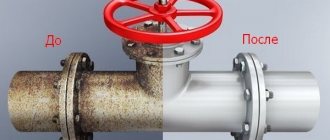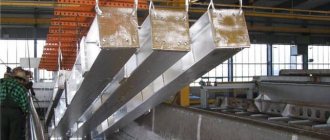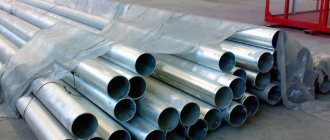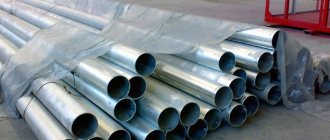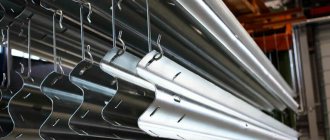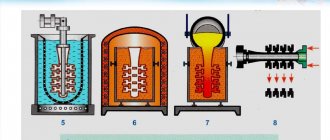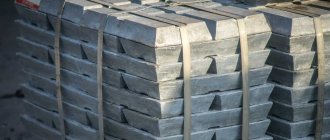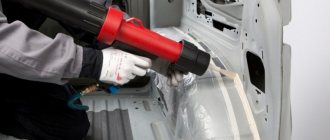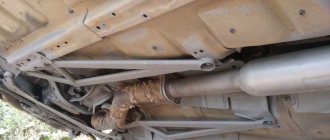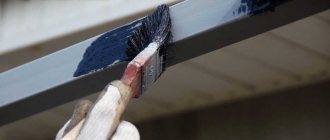Cold galvanizing effectively protects the surfaces of metal products from corrosion. The technology of cold galvanizing of metal consists of applying a special mixture to the metal, the chemical composition of which contains a lot of zinc. Iron rusts when it interacts with oxygen. To prevent this and extend the life of the product, protective measures are taken. Typically, a cold galvanizing compound is used. There are different methods for applying zinc.
Most experts consider galvanizing to be one of the best ways to protect metal structures from corrosion. Galvanic and hot galvanizing are used, providing the metal with anti-corrosion protection for decades (up to 50 years). Meanwhile, it is not always possible to apply these methods, since significant financial investments in technological equipment and special equipment are required.
Cold galvanizing technology
The surface treatment of metal structures is carried out using various anti-corrosion compositions, the compositional features, properties and characteristics of which are established by the profile standard - GOST 9.305-84.
This standard defines the requirements for metallic and non-metallic bases, the production of which was carried out using electrochemical and chemical methods.
According to the requirements of GOST 9.305-84, mixtures for cold galvanizing can be used on various structures, with the exception of parts made of high-strength steels and magnesium alloys. Before applying anti-corrosion compounds, the metal surface undergoes certain preparation.
Preparation work includes:
- removal of contaminants and salts by washing the surface;
- metal cleaning using abrasive blasting, waterjet or hydrodynamic methods, which allows you to remove rust and scale, as well as give the surface the desired level of roughness;
- drying the part if cleaning was carried out using a waterjet or hydrodynamic method;
- removal of burrs, sharp edges and cooking splashes (this work is done manually);
- cleaning dust by using air currents that are directed to the surface under high pressure.
Preparing metal structures involves completely cleaning the surface, on which there should be no grease or traces of oil (solvents are used for this).
Upon completion of the preparatory work, measures are taken to apply the selected composition to the surface of the product. The cold processing method involves maintaining a temperature in the room where the zinc composition is applied in the range from -20°C to +40°C.
At the same time, according to the recommendations of the manufacturers of such compositions, the surface of the workpiece should be at least 3°C above the dew point. If this condition is violated, moisture will form on the product, which will reduce the quality of the applied protective layer.
Calculate the dew point using a psychrometer, thermometer, hygrometer or other device. The readings obtained are compared with the parameters given in the table.
Dew point dependence on temperature and relative humidity
It is important to note that each subsequent layer of coating can be applied only after the previous layer has completely dried.
An anti-corrosion composition containing zinc is applied to the cleaned surface. To prevent the formation of condensation, the compositions should be applied taking into account the manufacturers' recommendations regarding operating temperatures.
Zinc paint is applied in several layers. In this case, each subsequent layer is applied only after the previous one has completely dried. Airless technology or the use of pneumatic spray guns can speed up paint drying.
The quality of the applied protective coating, as well as the level of adhesion, is checked using special measuring devices. A visual inspection is also carried out to identify areas that need rework and other coating defects.
Reviews
“I recently purchased a used car. At the beginning of the month I noticed that everything that the previous owner had diligently covered with paint began to rust. I bought an aerosol can of Galvanol and applied it in three layers. Of course, my fingers were frozen - it was winter outside, there was no garage, but it was worth it. I hope the coating won’t let you down” – Vasily.
“Last spring I was repairing a pipeline at the dacha and for a long time I could not choose a galvanizing agent, I was still afraid that I would inadvertently get poisoned by drinking water from such pipes. At the store, the consultants recommended "Galvanol". I bought it with caution, but I was more satisfied than ever” - Alexey.
“Two years ago I got a beautiful Volkswagen. Everything was fine, but at the service station they noticed rust, and later it was found on the door sills. It’s so offensive that you can’t help but cry. First I bought some kind of mixture, which fell off along with the rust a week after application. I was terribly upset again. The second time I came across a smart seller, who gave advice to treat it all with Galvanol. Finally, everything worked out, I was very happy” - Stepan.
Requirements of regulations and standards
Materials used for cold galvanizing of metal must necessarily meet the standards defined by GOST 9.305-84. Certain characteristics are regulated by a number of regulatory documents and standards: ISO 8502-3, GOST 12.2.052 and ISO 8503-1.
Thus, checking the quality of dust removal from the surfaces of metal structures is carried out by determining the volume and size of dust particles, which is prescribed in the provisions of the ISO 8502-3 standard.
The quality of degreasing is checked using the luminescent method, in accordance with the requirements of GOST 12.2.052, and the degree of roughness is determined using a classic profilometer or a special comparator - in accordance with the requirements of 8503-1.
What is the difference between hot and cold galvanizing technologies?
At the moment, there are two types of galvanizing - hot and cold methods. Hot-dip galvanizing technology was developed 160 years ago. After its discovery, this method of metal processing was recognized as a standard. This is due to the high degree of protection of the treated surfaces from corrosion processes. After its discovery, this method has not changed from a technical point of view.
The technology involves lowering a metal structure into a bath of zinc composition heated to a temperature of 400°C. After this, the product is hung until the coating is completely dry.
Thanks to the complete immersion of the structure in the anti-corrosion composition, it is possible to obtain a uniform coating, since in this way the zinc fills all existing cracks and hard-to-reach areas. The protective coating can last up to 60 years; the service period directly depends on the operating conditions.
The cold galvanizing method was invented in the 40s of the last century. Due to the practicality and relative ease of applying anti-corrosion compounds, the popularity of this technology is rapidly growing.
Eloquent proof of the reliability and durability of coatings applied using this technology is the largest water supply system in the world (460 km long), located in Australia.
The structure was processed in 1942 – 1944. despite the fact that the coverage has not been updated since that time. Keep in mind that in those days old equipment was used, and the thickness of one coating layer was only 75 microns.
Cold galvanizing of metal involves applying mixtures containing zinc in a volume of 92–96% to metal surfaces. Before the protective coating is applied, it is important to properly prepare the surface by thoroughly cleaning it from various contaminants.
Zinc-containing compounds can be applied by dipping the part or using a brush, roller and spray gun.
When is cold galvanizing used?
Cold galvanizing is widely used in the processing of automotive and ship parts, fittings and pipes, bridge structures, tanks and reservoirs, oil pipelines and other metal structures.
The wide scope of application is due to the following advantages of the technology:
- Zinc compounds are characterized by a high level of adhesion;
- Surface preparation does not require large financial investments;
- You can process structures and parts of different shapes and sizes;
- Application of a protective coating is allowed in domestic conditions;
- After processing, the structures are easy to weld;
- Parts can be processed in the following temperature conditions: from -20 to +40°C;
- There is no need for dismantling, transportation and re-installation of structures.
Application
Cold galvanizing compositions, subject to the rules of storage, application, and operation, professionally protect metal products and structures from destruction. Widely used in many fields.
- Mechanical engineering, automotive industry
- Pipelines, fittings, metal products
- Civil, industrial construction
- Energy, oil and gas complex
- Bridge slabs, supports
- Transport: sea, river, land
- Power line supports, road barriers
- Containers, reservoirs, cisterns (including for water)
- Hydro- and port structures, railway facilities
- Artistic forging.
Popular compositions for cold galvanizing
The technology for applying protective mixtures involves the use of different zinc-containing compounds.
The choice of a specific substance depends on many factors.
The following compositions allow you to obtain high antibacterial, barrier and cathodic protection:
| “Zinotan” is used to treat power line supports, pipes, hydraulic structures, tanks for various purposes and structures that come into direct contact with salt water and polluted environments. |
| “Galvanol” is used to protect equipment and structures that are exposed to salt solutions, alcohol vapors and other solutions. |
| “Master AK-100” is widely used for the protection of building structures, vehicles, power line supports, bridge structures and other metal structures. |
| “ZVES” is a binder made on the basis of ethyl silicate in combination with zinc powder, which has a high degree of dispersion. Used for processing structures made of high-alloy and ordinary steel. |
| “Zinconol” is a polyurethane zinc-containing primer, which is characterized by elasticity, good resistance to high temperatures and resistance to oils, petroleum products, gases, alkali vapors and sea water. |
| “Cinotherm” is an organosilicon solution that can be combined with perchlorovinyl, melamine and enamel paints and varnishes. |
Metal structures processed using cold galvanizing technology retain their original properties and qualities for a longer period of time than products processed by other traditional methods.
Despite the high protective characteristics that this technology allows to obtain, the coating procedure requires less labor than galvanic and hot-dip galvanizing of metal.
Metal corrosion - what is it?
Corrosion is a natural reaction of metal to contact with oxygen contained in the atmosphere or water. That is, we have classical oxidation, transforming the surface layers of the metal into its own oxides - rust.
But oxides of different metals have completely different properties. For example, iron oxide (“classic” rust) has only destructive consequences, leveling both the surface strength and the very integrity of the metal structure. In turn, aluminum and zinc oxides bring only benefits, forming a thin and durable film on the surface of these metals, protecting both from further (deep) oxidation and from other “troubles”.
This is why zinc, aluminum, titanium, chromium and a number of other metals are considered “stainless”. That is, a thin oxide film that appears after contact of a “pure” substance from this group with oxygen can protect the metal from further corrosion.
Moreover, this quality can be transferred to “ferrous” metals – cast iron and steel. To do this, you need to either “mix” a certain amount of a corrosion-resistant substance into the melting “ferrous” metal (this is how the famous “stainless steel” is obtained by adding 20-25 percent chromium to an iron-carbon alloy), or “coat” the rusting material with a layer of zinc or chromium.
Cold galvanizing of metal structures - nuances of the process
There are about six technological processes, the result of which will be the formation on the surface of a “ferrous” metal structure of an anti-corrosion barrier created on the basis of zinc. Moreover, cold galvanizing is the least energy-consuming and cheapest way to protect metal from rusting.
After all, cold working is, by and large, the usual coloring of metal, carried out with somewhat unusual compounds containing zinc and a volatile binder.
Moreover, thanks to the unusual properties of the “painting” composition, the porous protective coating, over time, transforms into an impenetrable barrier that protects the iron from most external threats. After all, after application, modern compounds are not only fixed on the surface of the ferrous metal, but also form an electrochemical “iron-zinc” pair that seals the coating structure.
As a result, modern compositions provide cold working technology with the highest performance, comparable to electrochemical or hot-dip galvanizing of metal structures.
